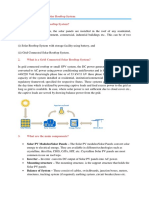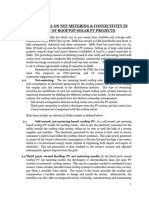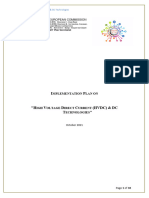Guideline 22
Guideline 22
Uploaded by
lyndonCopyright:
Available Formats
Guideline 22
Guideline 22
Uploaded by
lyndonOriginal Title
Copyright
Available Formats
Share this document
Did you find this document useful?
Is this content inappropriate?
Copyright:
Available Formats
Guideline 22
Guideline 22
Uploaded by
lyndonCopyright:
Available Formats
MINISTRY OF MINERAL RESOURCES, GREEN TECHNOLOGY AND ENERGY SECURITY
ROOFTOP SOLAR GUIDELINES
JUNE 2020
Table of Contents
1. Introduction ............................................................................................ 1
2. Glossary, Definitions & Abbreviations .................................................... 2
3. General Guidelines ................................................................................ 4
4. Eligibility................................................................................................. 6
5. Permitting & Licensing ........................................................................... 8
6. Access, Indemnity, Legal Requirements .............................................. 11
7. Technical Standards ............................................................................ 12
8. Metering, Billing and Other Related Costs ........................................... 12
9. Dispute Resolution............................................................................... 14
10. Auditing of RTS systems...................................................................... 14
11. Non-compliance ................................................................................... 14
12. Evaluation & Reporting ........................................................................ 15
13. Amendments ....................................................................................... 15
14. Implementation of the RTS Programme ............................................... 15
MMGE Rooftop Solar Guidelines i
1. Introduction
The overarching goal of Botswana’s National Energy Policy is to provide an affordable,
reliable and adequate supply of energy for sustainable development, as well as to
improve access to an efficient use of energy resources. The policy states that the
Government will support and facilitate initiatives that increase the contribution of solar
energy to the energy supply mix in order to attain energy security and a low carbon
portfolio. In its submission of its climate action plans to the United Nations Framework
Convention on Climate Change (UNFCCC) in 2015, Botswana committed to an overall
Greenhouse Gas (GHG) emission reduction of 15 per cent (from 2010 emissions level)
by 2030.
Botswana further committed to conducting the necessary legislative review, develop a
Climate Change Policy and Institutional Framework supported by relevant strategies to
achieve the intended reduction. To that end, the Government of Botswana is
implementing the Rooftop Solar Programme to create an environment in which end users
can generate their own electricity and sell any excess to Botswana Power Corporation
(BPC). The Programme is an alternative suitable mechanism to facilitate private sector
participation and increase the uptake of solar energy. It entails the development of
Rooftop Solar Guidelines, applicable rules, regulations, standards, tariffs as well as
review of processes. These Guidelines define the framework and administrative process
for the implementation of small scale grid-tied solar photovoltaic (PV) systems, either roof
or ground mounted. The system-wide aggregate capacity of the Programme in the first
12 months is 10 MW.
1. 1 Goal of the Guidelines
The goal of these Guidelines is to enable BPC electricity consumers to generate electricity
for their own use while selling any excess to BPC up to the limit as defined by the Ministry.
1. 2 Objectives
The objectives of these Guidelines are to provide:
i. The framework and administrative process for the implementation of small scale
grid-tied solar PV systems either roof or ground mounted;
ii. Guidance that will assist in the development of applicable rules, regulations, tariffs
and processes;
iii. Guidance to consumers on how they may use the RTS Programme in a compliant
manner to generate electricity for their own use and sell any excess to BPC; and
iv. Support for the evaluation of the effectiveness of this type of programme as one
part of an overall strategy for enhancing capacity and connectivity in Botswana’s
Electricity Sector.
MMGE Rooftop Solar Guidelines 1
2. Glossary, Definitions & Abbreviations
Bi-directional meter: A device that separately measures electricity flow in both directions
(import and export)
Consumer: means any person who is supplied with electricity for his/her own use by
BPC. Consumers who also generate will be referred to, herein, as “consumers”, although
in effect they are “consumer/generators”.
Consumption: Kilowatt hours (kWh) used by the consumer for his/her own use and
tracked by the BPC meter.
Export: Any kWh that is generated by the Rooftop Solar (RTS) system and sent to the
BPC grid through its Point of Connection.
Generating capacity: The maximum amount of electricity, measured in kilovolt Amperes
(kVA), which can flow out of the generation equipment into the consumer’s alternating
current wiring system. This is therefore the maximum alternating current power flow which
can be generated.
Grid-tied: Embedded generation, such as photovoltaic solar, that is connected to the
utility electricity grid either directly or through a consumer’s internal wiring is said to be
“grid-tied”. The export of energy onto the utility grid is possible when generation exceeds
consumption at any point in time. Such consumers would rely on the utility grid to supply
them with electricity when their instantaneous generation is insufficient to supply their
instantaneous consumption. Also known as “interconnected”.
Interconnection Agreement (ICA): A contract between the consumer and BPC that
details the terms and conditions of interconnecting an RTS system with the BPC grid. The
ICA, signed by both the consumer and BPC, and the Certificate of Completion constitutes
the Permit necessary for an RTS system.
Inverter: A power device that converts direct current to alternating current at a voltage
and frequency which enables the generator to be connected to the utility grid.
Licence: For RTS systems above 100 kW, a licence will be issued by BERA to verify that
the system meets the full intent and requirements of the Electricity Supply Act. The
Licence term will be for 15 years.
Licensed Technician or Engineer: This refers to a Technician or Engineer who is
certified by the Engineer’s Registration Board of Botswana.
MMGE Rooftop Solar Guidelines 2
Permit: A permit, comprised of the ICA signed by both the consumer and BPC as well as
the Certificate of Completion to verify that an RTS system as met all technical and safety
standards for interconnection with the system grid. The Permit term will be for 15 years.
Photovoltaic Solar System: A small scale embedded generation system, also known as
PV system or solar power system, designed to supply usable solar power by means of
photovoltaics. The system is comprised of solar panels to absorb and convert sunlight
into electricity, a solar inverter to change the electric current from DC to AC, as well as
mounting, cabling, and other electrical accessories to set up a working system.
Point of Connection: An electrical node on a distribution system where the consumer’s
electrical assets are physically connected to the utility’s grid (BPC).
Rooftop Solar: PV systems owned by consumers at the same location at which they
receive a bill for electric service. The generation from these facilities is primarily intended
for self-use, with excess generation eligible to be sold back to the grid.
Rooftop Solar Programme: A programme for grid-tied roof or ground-mounted solar PV
systems (with or without energy storage), owned by consumers at the same location at
which they receive their electricity bill. The generation from these facilities is primarily
intended for self-use, with excess generation eligible to be sold back to the grid. The
facilities may be roof or ground mounted and may include battery storage.
Utility: The electricity distribution service provider responsible for the electricity grid
infrastructure to which the consumer is connected.
Utility Network (or Utility Grid): The interconnected network of wires, transformers and
other equipment, covering all voltage ranges, and belonging to the Utility.
Abbreviations
AMI Advanced Metering Infrastructure
BERA Botswana Energy Regulatory Authority
DOE Botswana Department of Energy, under the Ministry of Mineral Resources,
Green Technology and Energy Security
kVA kilovolt-ampere (unit of electrical power, often similar in magnitude to kW)
kW kilowatt (unit of electrical power)
kWh kilowatt-hour
MMGE Ministry of Mineral Resources, Green Technology and Energy Security
MW Megawatt
PV Photovoltaic
RTS Rooftop Solar
MMGE Rooftop Solar Guidelines 3
3. General Guidelines
3.1. General definition of the Rooftop Solar Programme (RTS)
A programme for grid-tied roof or ground-mounted solar photovoltaic (PV) systems
(with or without energy storage), owned by consumers at the same location at which
they receive their electricity bill. The generation from these facilities is primarily
intended for self-use, with excess generation eligible to be sold to BPC.
3.2. Operating period
The RTS will align with and operate for the duration of the NDP11 (March 2023);
and upon its completion be evaluated for changes.
In the event of the Programme’s termination, any RTS-approved projects will be
eligible to continue to operate their RTS under the terms and conditions of the
Programme for the duration of the term of their permit or licence.
3.3. Relevant Legislation
The Guidelines seek to align with the following legislation:
i. Electricity Supply Act;
ii. Botswana Energy Regulatory Authority Act;
iii. Botswana Power Corporation Act and By-Laws;
iv. Environmental Impact Assessment Act;
v. Occupational Health and Safety Act;
vi. Trade Disputes Act; and
vii. Any applicable law of the Republic of Botswana
3.4. General Roles and Responsibilities of Key Stakeholders.
The Department of Energy (DOE), under the Ministry of Mineral Resources, Green
Technology and Energy Security (MMGE) shall be responsible for the oversight and
policy direction of the Rooftop Solar Programme, providing general guidance
through the Rooftop Solar Guidelines.
BERA shall be responsible for developing the necessary regulations, aligned with
the Rooftop Solar Guidelines as needed to guide the interconnection process, set
tariffs, establish tariff methodologies, and oversee safety concerns. It will also be
responsible for issuing permits and/or licenses, as specified in further detail below.
MMGE Rooftop Solar Guidelines 4
BPC shall set design standards and specifications, interpret and implement the
provisions of the policy and regulations, thereby allowing Consumers to interconnect
their rooftop solar system to the grid. BPC may also propose changes to BERA on
matters that are subject to BERA regulatory approval, for BERA’s consideration and
approval. In the process, it should ensure overall safety, adherence to the overall
technical guidelines, and follow good commercial practices.
The Consumer shall ensure compliance with the Guidelines in the event the
Consumer decides to sign up for the RTS Programme and meets the eligibility
criteria. Such compliance includes the engagement of a licensed Electrician,
Technician or Engineer to design the solar system; ensuring that the Consumer
obtains all the applicable permits and licenses as provided for in the Guidelines, and
ensuring the timely payment of all costs and charges that the Consumer is
responsible for as detailed in the Guidelines such as the installation costs.
MMGE Rooftop Solar Guidelines 5
4. Eligibility
4.1. Eligibility Criteria
To be eligible for this Programme a consumer shall:
i. be a BPC consumer;
have title to the Rooftop Solar System.
ii. site the system on the same property as the meter that will measure the
consumption and export of the electricity;
iii. adhere to the limitations in capacity and sizing contained herein; specifically,
the following capacity limitations apply to this Programme:
a. Domestic – up to 35 kW of generating capacity.
b. Commercial & Industrial – up to 1 MW of generating capacity.
Additionally, the size of a system may not exceed 110% of the consumer’s
consumption over the 12-month period immediately preceding the date of
application.
Consumers are allowed to apply for multiple permits and/or licenses, as
long as the total generating capacity of the RTS systems does not exceed
35 kW for each domestic consumer and 1 MW for each Commercial &
Industrial consumer.
Example 1: A domestic consumer owning two properties may apply to the Rooftop
Solar Programme for each property to have a solar photovoltaic system, if all
criteria are met from Section 4.1, and that the generating capacity equals no more
than 35 kW. Therefore, each property could have the following roof or ground-
mounted RTS systems:
i. 5 kW and 10kW, totaling 15 kW; or,
ii. 15 kW and 20 kW, totaling 35 kW
Example 2: A C&I consumer, meeting the above criteria from Section 4.1, with the
generating capacity not exceeding 1MW, each property could have the following
RTS systems: 300 kW and 250 kW and 350 kW, totaling 900 kW.
MMGE Rooftop Solar Guidelines 6
4.2. System Design
It is the responsibility of the consumer to engage a licensed Electrician, Technician
or Engineer in designing the solar system. A system can be mounted on a building
roof or ground-mounted.
The RTS systems should be designed with Islanding Protection feature to detect
loss of grid power and automatically (within two seconds) shuts off the solar inverter
irrespective of connected loads to stop feeding power back to the grid. The
Consumer may choose the design that allows their system to remain operational in
isolation from the grid for own consumption, which may require additional
equipment.
4.3. Energy Storage
A consumer may also install energy storage at the consumer’s discretion.
MMGE Rooftop Solar Guidelines 7
5. Permitting & Licensing
5.1. System-wide aggregate capacity
This nationwide Programme is limited to system-wide aggregate capacity of 10 MW
for the first 12 months of the Programme. Twenty percent, or 2 MW, will be reserved
for domestic consumers. Thereafter, the Ministry, in consultation with BPC, will
determine the system-wide aggregate capacity for the remaining tenure of the
Programme.
5.2. Definitions of Licence and Permits for RTS systems
For all domestic and C&I projects in this Programme, the RTS consumer must obtain
a Permit, to ensure that its project meets all technical and safety standards. The
Permit constitutes the Interconnection Agreement and the Certificate of Completion,
as described below:
i. Interconnection Agreement (ICA) – A consumer is required to execute
an ICA with BPC. The ICA for domestic consumers will be standardized
and simplified, requiring minimum terms and conditions relating to safety
and technical standards.
ii. Certificate of Completion – After installation and inspection of the RTS
system, BPC (or its representative) will certify its completion, deeming the
ICA as final and in effect.
For C&I projects sized between 100 kW to 1 MW, the RTS consumer must obtain
a Licence (over and above the Permit), according to the BERA Act.
5.3. Permit and Licence Terms
The term of the Permit (ICA) and/or Licence will be for 15 years, upon which time it
will require renewal. In event of Programme termination, an RTS-approved project
will be able to continue to operate under the terms and conditions of the Permit or
Licence until the expiration date of that Permit or Licence.
5.4. Application Process
5.4.1 Potential RTS consumer applies with BPC to install a system of a certain
size on its property. Until the aggregate capacity limit is reached, consumers
gain access to the Programme on a first come-first served basis.
MMGE Rooftop Solar Guidelines 8
5.4.2 Documents required are filed with BPC, through an online application
system:
5.4.2.1 Application –The Application Form shall provide for an attestation
that all environmental requirements have been (or will be) met. BPC will
confirm the electricity needs after receipt of the application. The Application
Form will be completed online, directly on the BPC website.
For PV systems greater than 100 kW, the application will be automatically
forwarded to BERA for review and issuance of a Licence to the consumer.
BERA will inform BPC of the issuance of such applicable authorization.
5.4.2.2 Interconnection Agreement – A conditional standard ICA developed
by BPC and approved by BERA. The ICA will be signed by the consumer
and BPC, prior to installation, agreeing to install the system per the terms
and conditions of the Interconnection Agreement.
For PV systems greater than 100 kW, the conditional ICA will be signed by
the consumer and BPC, upon approval of the Licence by BERA.
5.4.3. If all documents are in order, BPC puts the consumer and the amount in
the queue. The capacity requested is subtracted from the running balance of
Programme capacity available. BPC will conduct necessary studies or
analyses to confirm availability request at the Point of Connection. BPC will
notify the consumer of the outcome of their application.
5.4.4 BPC will maintain a Registry of such systems, providing access to BERA,
that will include information provided from the Application and any other
relevant data. BPC will regularly monitor for Permits (ICA) expiring, while BERA
will monitor for licenses that may be expiring.
5.4.5 The consumer will have a set amount of time as determined by BERA,
upon application from BPC, to install and certify the system.
5.4.6 The consumer and its representative Licensed Electrician, Technician or
Engineer will commission the system for Certification. BPC, or its
representative, may elect to witness this commissioning. Authorized
representatives of BPC may be a Licensed Electrician, Technician or Engineer.
For systems sized between 100 kW to 1 MW, BERA may also witness the
commissioning. The Certification process shall be to ensure that the system
meets all the conditions of the Interconnection Agreement. Upon Certification,
the BPC representative shall sign the Certificate of Completion on behalf of
BPC, deeming the ICA as final and in effect.
MMGE Rooftop Solar Guidelines 9
5.4.7 The system is eligible to be put into service upon certification.
5.4.8 If the consumer does not receive certification for its system within the time
frame allowed, the capacity is added back into the Programme capacity
available and the consumer is removed from the Registry. BPC will determine,
in consultation with BERA and the Ministry, an appropriate timeframe allowed.
5.4.9 For good cause, if the consumer requests, BPC may grant an extension
to the deadline, in consultation with BERA.
5.4.10 If the consumer is removed from the Registry, it then must reapply anew
in order to be placed back on the Registry.
5.5. Renewal and Expansion of Systems
5.5.1 Renewal of System – BPC will notify a consumer within 60 days of the
expiration of the Permit. If planning to renew, the consumer must submit its
intent to do so and complete the Application Process from 6.4.6 above. Upon
receipt of Certificate of Completion, BERA will renew the term of Licence for
projects above 100 kW.
5.5.2 Expansion of System – If a consumer intends to expand a system with
a current Permit or Licence, the consumer must follow the entire Application
Process anew.
MMGE Rooftop Solar Guidelines 10
6. Access, Indemnity, Legal Requirements
6.1. Right to curtail
In the event of operating conditions that may result in BPC electrical grid parameters
not meeting minimum quality of supply, safety standards or non-availability of an off-
taker, it may become necessary to curtail Rooftop Solar consumers. It is expected
that these limitations would be of a temporary nature, applied only during abnormal
system conditions or low load periods.
6.2. Adapting rules & regulations
In the event of changes to the energy sector or associated relevant rules,
regulations, policies, laws and/or standards, Rooftop Solar Programme customers
may be required to upgrade these systems to meet new specifications or standards.
Existing RTS consumers may be exempted from amendments unless BPC files
application, agreed to by BERA, to require remediation to rooftop solar projects.
Those PV systems currently connected to BPC grid but not exporting power are
eligible to apply for this Programme.
6.3. Right to deny access
BPC has the right to deny access to any RTS consumer to interconnect with the
system grid. It is mandatory that all consumers wishing to install a Rooftop Solar
system, regardless of generation capacity, complete the relevant sections of the
application process in full, and that the Conditional ICA is signed by BPC before
system installation commences. BPC will ensure that, amongst other
considerations, there is availability of capacity to accommodate the Rooftop Solar
system. If the consumer is willing to take on the necessary upgrades and its
associated costs to interconnect, then BPC may consider the Application.
Consumers should not purchase equipment prior to signing the Conditional ICA, as
approval is not guaranteed and BPC shall not be held liable for equipment expenses
where approval is denied.
6.4. Change of Ownership
If a transfer of ownership of a property takes place in which an RTS system is
installed, the current owner will need to notify BPC of the change and the new owner
will be required to sign a new ICA. For projects above 100 kW, BPC would forward
the request for a Change of Ownership to BERA to amend the Licence accordingly.
Alternatively, the RTS system should be disconnected and removed from the
Programme.
MMGE Rooftop Solar Guidelines 11
6.5. Removal or Decommissioning of System:
If a consumer decides to remove or cease operation of the RTS system, BPC must
be notified, and BPC must verify that the system has been physically disconnected
from the grid. For projects above 100 kW, the consumer will also need to notify
BERA of the discontinuance of the Licence. Costs to remove wiring which connects
the inverters with the grid will be borne by the consumer. BPC will provide a
Certificate of Compliance that the system has complied with removal and
decommissioning procedures and update the Registry as such.
7. Technical Standards
RTS systems should comply with the necessary standards and regulations in order
for the system to be approved and put into operation. In addition to the legislation
listed above in Section 3.3, BPC, in consultation with BERA, will provide the
minimum applicable technical standards as contemplated in the RTS rules and
regulations to the RTS Programme on its website as well as referenced within the
ICA’s terms and conditions to ensure full compliance, a consumer should engage
a licensed Electrician, Technician or Engineer.
8. Metering, Billing and Other Related Costs
8.1. Good standing of Accounts
Consumers should be in good standing with BPC. RTS applicants in arrears will not
be considered.
8.2. Who pays for what:
8.2.1 The consumer is responsible for any installation costs from the Point of
Interconnection (typically the meter for a domestic consumer).
8.2.2 If the system network is oversubscribed or cannot accommodate the
RTS system, the consumer will be responsible for any changes (and the
associated costs) required to the utility network upstream of the connection
point to proceed with its interconnection.
8.2.3 The consumer is responsible for the cost of any special grid studies or
tests that need to be carried out to obtain the required ICA.
MMGE Rooftop Solar Guidelines 12
8.3. Metering
A bi-directional meter, with four quadrant capability to support independent registers
for import (kWh consumed), export (kWh generated) and net measurements
regardless the meter mode of operation (prepaid/postpaid) as determined by BPC
will be provided and installed by BPC at the consumer’s cost. The same meter will
be of multiple tariff to support the required time of use (TOU) tariff. The meter will
be owned by BPC as a non-utility funded asset.
For the purposes of gathering statistics on renewable energy production, it is
recommended that installations below 100 kW should install their own energy meter
to record the RTS plant energy production. For installation at or above 100 kW it is
mandatory that consumer has the energy meter on their RTS plant.
8.4. Billing
Consumers are billed according to the regular billing cycle for kWh. Excess kWh
generated and exported to the grid over the consumer’s use are credited towards
the next billing cycle. The kWh generated less consumed should be clearly
represented on each monthly bill.
The meter will register the energy imported from BPC and the excess energy
exported to BPC. These two, energy imported from and exported to BPC will be
reconciled on monthly basis to also reflect the Net energy. For every kWh the
consumer exports to the grid, they will receive a credit of 1kWh. The credit received
shall not be in monetary terms but in kWh. Any excess energy exported by the
consumer will be rolled over to the next billing cycle. Only the charges relating to the
kWh units, energy part, of the consumer bill are affected, the fixed charge part, non-
energy part of the consumer’s bill will not be credited for excess energy exported to
BPC. If, over any particular month, the customer is a net importer (their net export
is negative), the customer will be billed for the energy supplied during that month as
per the approved BPC tariff schedule.
For applicable consumers accruing demand charges, aggregate demand will be
adjusted over each billing cycle for the first 12 months of the RTS system’s
operation.
8.5. Banking of kWh credits
Credits will be carried forward for a duration of 12 months, known as “banking”.
Upon which time, BPC will reconcile the consumer “bank” and pay the consumer for
the remaining credits. Any banked kWh should be clearly represented on each
monthly bill.
MMGE Rooftop Solar Guidelines 13
BPC will pay the consumer for any banked credits at the avoided cost rate. The
avoided cost rate, or wholesale cost of power and its distribution, will be
determined by BPC on an annual basis, as approved by BERA and advised to
consumers.
The cost will be informed by the applicable tariff at the time of use. For example,
the meter will be configured based of the pre-determined TOU tariff such that any
excess power exported to BPC during off-peak hours will be of standard tariff and
any export at peak hours will be registered at a non-standard tariff which will be a
little more expensive.
8.6. Arrearages
If a consumer becomes in arrears with an operational RTS solar system, routine
disconnection and reconnection procedures will apply.
9. Dispute Resolution
Any disputes between BPC and the RTS consumer may be resolved promptly through
mutual consultations. Further grievance shall have recourse under the relevant
regulations under BERA’s jurisdiction.
10. Auditing of RTS systems
BPC will periodically audit a sample of RTS systems, as per the procedures approved by
BERA, conducting an inspection of such systems to ensure all technical and safety
standards are met. Thereafter, BPC will submit in its audit findings to BERA. All
documentation and information pertaining to the auditing and site visits will be retained
by BPC for BERA and the Ministry to review upon request.
11. Non-compliance
If at any time an RTS system is not complying with the Guidelines, Rules or associated
regulations for this Programme (e.g., technical, safety, environmental), BPC may
disconnect the consumer’s system immediately and without notice, and notify BERA of
the system’s non-compliance. BERA has the authority to impose sanctions for non-
compliance with Guidelines and Rules.
MMGE Rooftop Solar Guidelines 14
12. Evaluation & Reporting
BPC will report on a quarterly basis the performance of the Rooftop Solar Programme.
The report should include the following data and analyses:
i. any technical and/or financial issues;
ii. aggregate kWh generated and exported, as well as other relevant data;
iii. number of active and decommissioned RTS systems, including geographical
(city, zone, feeder, etc.) and demographic information captured from the net
metered participant register; and
iv. audit findings.
At the end of the first 12-month term of the Programme, the Ministry will announce its
determination of aggregate maximum capacity within the system grid.
13. Amendments
The Minister reserves the right, at his discretion, to change or modify these Guidelines at
any time. If the minister makes a change to the Guidelines, any application that has been
filed will be processed under the (old) Guidelines in effect at the time the application was
filed.
14. Implementation of the RTS Programme
Implementation of the RTS Programme will be subject to all applicable policies and
relevant laws of the Republic of Botswana.
MMGE Rooftop Solar Guidelines 15
MMGE Rooftop Solar Guidelines 2
You might also like
- Guidelines On Rooftop Solar PV Installation For Utility Providers May 2022No ratings yetGuidelines On Rooftop Solar PV Installation For Utility Providers May 202222 pages
- Guidelines On Rooftop Solar PV Installation For Utility Providers Revision 1No ratings yetGuidelines On Rooftop Solar PV Installation For Utility Providers Revision 124 pages
- ODISHA Net Metering (August 2016 As Amended Upto 17.01.2018)No ratings yetODISHA Net Metering (August 2016 As Amended Upto 17.01.2018)19 pages
- Connection Conditions For Generators of Electricity From Solar EnergyNo ratings yetConnection Conditions For Generators of Electricity From Solar Energy12 pages
- ST Solar Guide Guide - CGPP - Version - November - 2023No ratings yetST Solar Guide Guide - CGPP - Version - November - 202343 pages
- Cebu Solar Veco Net Metering Proposal 11011No ratings yetCebu Solar Veco Net Metering Proposal 110115 pages
- Development of Bidirectional Net Meter in Grid Connected Solar PV System For Domestic ConsumersNo ratings yetDevelopment of Bidirectional Net Meter in Grid Connected Solar PV System For Domestic Consumers5 pages
- Smart Grid Mandate Standardization Mandate To European Standardisation Organisations (Esos) To Support European Smart Grid DeploymentNo ratings yetSmart Grid Mandate Standardization Mandate To European Standardisation Organisations (Esos) To Support European Smart Grid Deployment8 pages
- Department OF Electrical Engineering Semester - 06 GREEN TECHNOLOGY (4360904)No ratings yetDepartment OF Electrical Engineering Semester - 06 GREEN TECHNOLOGY (4360904)28 pages
- CIGRE-156 Smart Grids - A Network Perspective On Renewable Integration and Self-Healing NetworksNo ratings yetCIGRE-156 Smart Grids - A Network Perspective On Renewable Integration and Self-Healing Networks7 pages
- Www1.eere - Energy.gov Solar Pdfs Segis Concept Paper PDFNo ratings yetWww1.eere - Energy.gov Solar Pdfs Segis Concept Paper PDF29 pages
- Rooftop Solar PV System: RU-44-03-0025-280422/FAQNo ratings yetRooftop Solar PV System: RU-44-03-0025-280422/FAQ3 pages
- Design and Implementation of A G P Photovoltaic Maximum Power Point TrackerNo ratings yetDesign and Implementation of A G P Photovoltaic Maximum Power Point Tracker55 pages
- EN 25 - 2016 - TT-BCT - 339051 THÔNG TƯ 252016TT-BCT NGÀY 30112016 QUY ĐỊNH HỆ THỐNG ĐIỆN TRUYỀN TẢI DO BỘ TRƯỞNG BỘ CÔNG THƯƠNG BAN HÀNHNo ratings yetEN 25 - 2016 - TT-BCT - 339051 THÔNG TƯ 252016TT-BCT NGÀY 30112016 QUY ĐỊNH HỆ THỐNG ĐIỆN TRUYỀN TẢI DO BỘ TRƯỞNG BỘ CÔNG THƯƠNG BAN HÀNH48 pages
- Energy Conversion and Management Ass. 01No ratings yetEnergy Conversion and Management Ass. 0114 pages
- New Repair and Expansion of Existing HWLC Systems Programe RulesNo ratings yetNew Repair and Expansion of Existing HWLC Systems Programe Rules12 pages
- State of The Art in Distribution Network OperationsNo ratings yetState of The Art in Distribution Network Operations3 pages
- Commission Regulation (Eu) 2017/2196 of 24 November 2017 Establishing A Network Code On Electricity Emergency and RestorationNo ratings yetCommission Regulation (Eu) 2017/2196 of 24 November 2017 Establishing A Network Code On Electricity Emergency and Restoration40 pages
- Guidelines For Installing Solar PV Power PlantNo ratings yetGuidelines For Installing Solar PV Power Plant3 pages
- Maharashtra Energy Development Agency: Grid Connected Rooftop System (GCRT)No ratings yetMaharashtra Energy Development Agency: Grid Connected Rooftop System (GCRT)6 pages
- SETPlan HVDC DC Tech ImplementationPlan FinalNo ratings yetSETPlan HVDC DC Tech ImplementationPlan Final40 pages
- 3 Masterclass Solar - For Solar Batch FT BNo ratings yet3 Masterclass Solar - For Solar Batch FT B145 pages
- IEM - 15 - Grid-Connected Photovoltaic Systems An Overview of Recent Research and Emerging PV Converter Technology - 1No ratings yetIEM - 15 - Grid-Connected Photovoltaic Systems An Overview of Recent Research and Emerging PV Converter Technology - 136 pages
- 10.SEC - Standards For The Connection of Small Scale Solar PV - v3 - Clean100% (1)10.SEC - Standards For The Connection of Small Scale Solar PV - v3 - Clean45 pages
- Innovation Landscape brief: Behind-the-meter batteriesFrom EverandInnovation Landscape brief: Behind-the-meter batteriesNo ratings yet
- Dokumen - Tips Large Power Transformers and The Us Electric Grid Report UpdateNo ratings yetDokumen - Tips Large Power Transformers and The Us Electric Grid Report Update52 pages
- Ingecon Sun Storage FSK C Series 1500v Datasheet en 2021 12No ratings yetIngecon Sun Storage FSK C Series 1500v Datasheet en 2021 124 pages
- Generator Circuit Breaker Brochure Retrofit Application Brochure GB FR FR PDFNo ratings yetGenerator Circuit Breaker Brochure Retrofit Application Brochure GB FR FR PDF8 pages
- Intelligent MPPT Control For SEPIC-Luo Converter in Grid Tied Photovoltaic SystemNo ratings yetIntelligent MPPT Control For SEPIC-Luo Converter in Grid Tied Photovoltaic System11 pages
- Off-Grid Solution With ESS Capability en V1.0No ratings yetOff-Grid Solution With ESS Capability en V1.024 pages
- Terminal Blocks ALPHA FIX 201612161518498765No ratings yetTerminal Blocks ALPHA FIX 201612161518498765226 pages
- Presentation On Commissioning of CFBC Boiler100% (3)Presentation On Commissioning of CFBC Boiler26 pages
- EirGrid System Restoration Plan IrelandNo ratings yetEirGrid System Restoration Plan Ireland29 pages
- Undergraduate Thesis Topics Electrical Engineering100% (1)Undergraduate Thesis Topics Electrical Engineering8 pages
- Arduino Based EMS of A MicroGrid Using MAS PDFNo ratings yetArduino Based EMS of A MicroGrid Using MAS PDF8 pages
- The Massive Penetration of Inverter-Based Resources: Is Grid Forming Control Sufficient?No ratings yetThe Massive Penetration of Inverter-Based Resources: Is Grid Forming Control Sufficient?17 pages
- Guidelines On Rooftop Solar PV Installation For Utility Providers May 2022Guidelines On Rooftop Solar PV Installation For Utility Providers May 2022
- Guidelines On Rooftop Solar PV Installation For Utility Providers Revision 1Guidelines On Rooftop Solar PV Installation For Utility Providers Revision 1
- ODISHA Net Metering (August 2016 As Amended Upto 17.01.2018)ODISHA Net Metering (August 2016 As Amended Upto 17.01.2018)
- Connection Conditions For Generators of Electricity From Solar EnergyConnection Conditions For Generators of Electricity From Solar Energy
- ST Solar Guide Guide - CGPP - Version - November - 2023ST Solar Guide Guide - CGPP - Version - November - 2023
- Development of Bidirectional Net Meter in Grid Connected Solar PV System For Domestic ConsumersDevelopment of Bidirectional Net Meter in Grid Connected Solar PV System For Domestic Consumers
- Smart Grid Mandate Standardization Mandate To European Standardisation Organisations (Esos) To Support European Smart Grid DeploymentSmart Grid Mandate Standardization Mandate To European Standardisation Organisations (Esos) To Support European Smart Grid Deployment
- Department OF Electrical Engineering Semester - 06 GREEN TECHNOLOGY (4360904)Department OF Electrical Engineering Semester - 06 GREEN TECHNOLOGY (4360904)
- CIGRE-156 Smart Grids - A Network Perspective On Renewable Integration and Self-Healing NetworksCIGRE-156 Smart Grids - A Network Perspective On Renewable Integration and Self-Healing Networks
- Www1.eere - Energy.gov Solar Pdfs Segis Concept Paper PDFWww1.eere - Energy.gov Solar Pdfs Segis Concept Paper PDF
- Design and Implementation of A G P Photovoltaic Maximum Power Point TrackerDesign and Implementation of A G P Photovoltaic Maximum Power Point Tracker
- EN 25 - 2016 - TT-BCT - 339051 THÔNG TƯ 252016TT-BCT NGÀY 30112016 QUY ĐỊNH HỆ THỐNG ĐIỆN TRUYỀN TẢI DO BỘ TRƯỞNG BỘ CÔNG THƯƠNG BAN HÀNHEN 25 - 2016 - TT-BCT - 339051 THÔNG TƯ 252016TT-BCT NGÀY 30112016 QUY ĐỊNH HỆ THỐNG ĐIỆN TRUYỀN TẢI DO BỘ TRƯỞNG BỘ CÔNG THƯƠNG BAN HÀNH
- New Repair and Expansion of Existing HWLC Systems Programe RulesNew Repair and Expansion of Existing HWLC Systems Programe Rules
- State of The Art in Distribution Network OperationsState of The Art in Distribution Network Operations
- Commission Regulation (Eu) 2017/2196 of 24 November 2017 Establishing A Network Code On Electricity Emergency and RestorationCommission Regulation (Eu) 2017/2196 of 24 November 2017 Establishing A Network Code On Electricity Emergency and Restoration
- Maharashtra Energy Development Agency: Grid Connected Rooftop System (GCRT)Maharashtra Energy Development Agency: Grid Connected Rooftop System (GCRT)
- IEM - 15 - Grid-Connected Photovoltaic Systems An Overview of Recent Research and Emerging PV Converter Technology - 1IEM - 15 - Grid-Connected Photovoltaic Systems An Overview of Recent Research and Emerging PV Converter Technology - 1
- 10.SEC - Standards For The Connection of Small Scale Solar PV - v3 - Clean10.SEC - Standards For The Connection of Small Scale Solar PV - v3 - Clean
- Innovation Landscape brief: Behind-the-meter batteriesFrom EverandInnovation Landscape brief: Behind-the-meter batteries
- Advanced Smartgrids for Distribution System OperatorsFrom EverandAdvanced Smartgrids for Distribution System Operators
- Dokumen - Tips Large Power Transformers and The Us Electric Grid Report UpdateDokumen - Tips Large Power Transformers and The Us Electric Grid Report Update
- Ingecon Sun Storage FSK C Series 1500v Datasheet en 2021 12Ingecon Sun Storage FSK C Series 1500v Datasheet en 2021 12
- Generator Circuit Breaker Brochure Retrofit Application Brochure GB FR FR PDFGenerator Circuit Breaker Brochure Retrofit Application Brochure GB FR FR PDF
- Intelligent MPPT Control For SEPIC-Luo Converter in Grid Tied Photovoltaic SystemIntelligent MPPT Control For SEPIC-Luo Converter in Grid Tied Photovoltaic System
- Undergraduate Thesis Topics Electrical EngineeringUndergraduate Thesis Topics Electrical Engineering
- The Massive Penetration of Inverter-Based Resources: Is Grid Forming Control Sufficient?The Massive Penetration of Inverter-Based Resources: Is Grid Forming Control Sufficient?

























































































